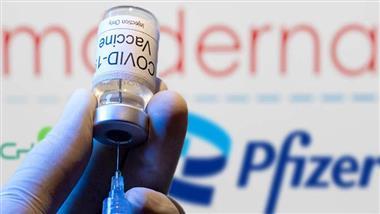BioNTech RNA-Based COVID-19 Injections Contain Large Amounts of Residual DNA
 –>
–>
Introduction
In 2020, politically promoted campaigns like “Operation Warp Speed” [1,2] and “Project Lightspeed” [3,4] pushed the development of a completely new class of drugs finally aiming at vaccinating seven billion people worldwide against COVID-19 [5]. These so-called “mRNA-vaccines” – hereinafter referred to as RNA injections or RNA biologicals – consist of nucleoside-modified mRNA (modRNA) packaged in transfection-competent lipid nanoparticles (LNP). According to the underlying idea, modRNA, once in the cell, forces this cell to produce SARS-CoV-2 spike proteins and present it on the cell surface, subsequently resulting in the stimulation of the immune system to generate specific antibodies against the presented spike antigen [6,7]. The “speed of science” [8] and the demand of the governments worldwide faced the manufacturers with the challenge to produce large amounts of modRNA within a very short time. Thus, the initial PCR-based process for the generation of the DNA matrices (process-1) for modRNA production, which received authorization for use in the phase-3 clinical trial, very soon reached its limits and the companies switched to a large-scale production of DNA matrices via cloned shuttle vectors, which can be easily multiplied in bacterial cell culture systems (process-2) [9]. Starting with the governmental vaccine roll-out, this process-2 product was employed instead of the original product.
Already in 2021, it has been reported that the modRNA-induced spike proteins could be found circulating in the blood of vaccinees weeks after the injections [10]. In 2022, the first detailed post-mortem investigation revealed the presence of vaccine-induced spike proteins at multiple locations in vessel walls and different tissues weeks after the last BNT162b2 injection [11]. Recently, vaccine-induced spike proteins were identified in placentas of women injected with RNA biologicals during pregnancy [12]. Dhuli and colleagues reported the presence of a sequence corresponding to a fragment of the modRNA in blood cells of long-COVID patients with a history of two doses of the BioNTech/Pfizer vaccine [13]. Importantly, the production of spike proteins by the body cells is not restricted to the injection area and did not terminate within a few days as had been proclaimed by the manufacturers and the responsible authorities. Several mechanisms have been suggested so far that could contribute to the remarkable long-lasting expression of spike proteins in vaccinated individuals.
First, biologicals contain nucleoside-modified mRNA (modRNA) to extend its lifetime [14], to reduce its destruction by turning off toll-like receptor detection [15], and to maximize its translation. This was achieved by replacing natural uridines with synthetic N1-methyl-pseudouridines (mPsi) and by increasing the content in guanine and cytosine (known as codon optimization) [6,14,16].
Second, transfected modRNA may be reverse transcribed into DNA and integrated into the cell´s genome via a LINE1 (Long Interspersed Nuclear Element-1) mediated mechanism, as data from transfection experiments in human cell lines HEK293T [17] and Huh7 [18] suggested.
Third, lipid nanoparticles (LNP) delivering modRNA to the cells may also contain DNA, which originated from the production process, where spike-coding DNA was used as a template for the in-vitro transcription of modRNA. Remaining DNA may not completely be separated from modRNA and degraded by deoxyribonuclease-I (DNase-I) digestion and, subsequently, be packaged in the LNP together with the modRNA. It is well known that DNase-I can adhere to the surfaces of reaction vessels and can exhibit reduced efficiency in the presence of hybrids of DNA and RNA [19]. According to a manufacturer, it is “probably impossible to remove every single strand of DNA in an RNA preparation” [20]. Given the fact that the European Medicines Agency and the German Paul Ehrlich Institute fixed a residual DNA of 10 ng per injected clinical dose as acceptable (and indeed DNA up to this margin was shown in the registration documents [9]), it makes a packaging of this DNA into the lipid nanoparticles highly likely.
This possibility emerged on the scene in February 2023, when McKernan and colleagues announced the discovery of large amounts of both spike-coding DNA and residual plasmid-DNA derived from the expression vector system in BioNTech/Pfizer and Moderna vaccine lots [21,22]. The bulk was represented by fragmented, linearized DNA, but also intact plasmids being able to successfully transfect E. coli cells [21,22]. Assuming that these intact plasmids were packaged in the LNP together with the modRNA, stable expression vectors could enter the cells and thus provide a rich source of long-lasting spike production in the case that the cells are able to transcribe the coded spike region. Incomprehensibly, plasmids from BioNTech/Pfizer, but not from Moderna, do not only contain the bacterial T7 promoter system, but also the mammalian Simian Virus 40 (SV40) promoter/enhancer sequence [23-25]. This gives cause for concern, as already in 1999, Dean and colleagues demonstrated that nuclear entry of plasmid-DNA, especially in non-dividing cells, requires a 72 bp sequence of the SV40 promoter/enhancer [23]. Of note, neither the promoter, nor the origin of replication are needed for nuclear localization of plasmid-DNA [23]. Meanwhile, the results of the McKernan team have been confirmed and extended [26]. Recently, König and Kirchner published data on large amounts of residual DNA within several BNT162b2 lots [27].
Against this background, we performed a series of experiments to answer the following urgent questions. First, can the large amount of residual DNA in BioNTech lots [27] and even plasmids identified in Pfizer lots [21,22] be confirmed on BioNTech only lots (BNT162b2, Comirnaty) distributed in Germany by different comparable DNA detection methods? Second, can residual plasmids or DNA fragments, if present, be efficiently transfected into human cells together with the coding modRNA? Third, can these biologicals induce continued cellular expression of spike protein thus creating long-term foci for immune attack? To answer these questions, we applied an in-vitro cell culture model using HEK293 cells, as these cells simulate dividing human cells and, therefore, are not only a suitable target for protein production but are also most susceptible for a potential interaction of the transfected foreign nucleic acids and the cell´s genome. The fact that we obtained positive results on all issues raises the strongest concerns on the safety of the BNT162b2 vaccine.
Click here to read the report.
*
Click the share button below to email/forward this article to your friends and colleagues. Follow us on Instagram and Twitter and subscribe to our Telegram Channel. Feel free to repost and share widely Global Research articles.
Global Research’s Holiday Fundraiser
Featured image is from Mercola


